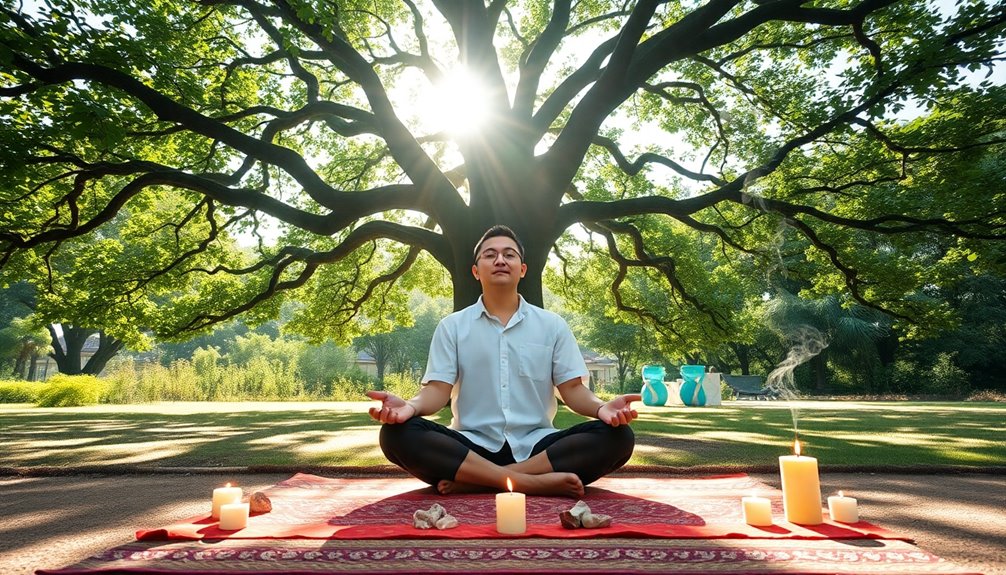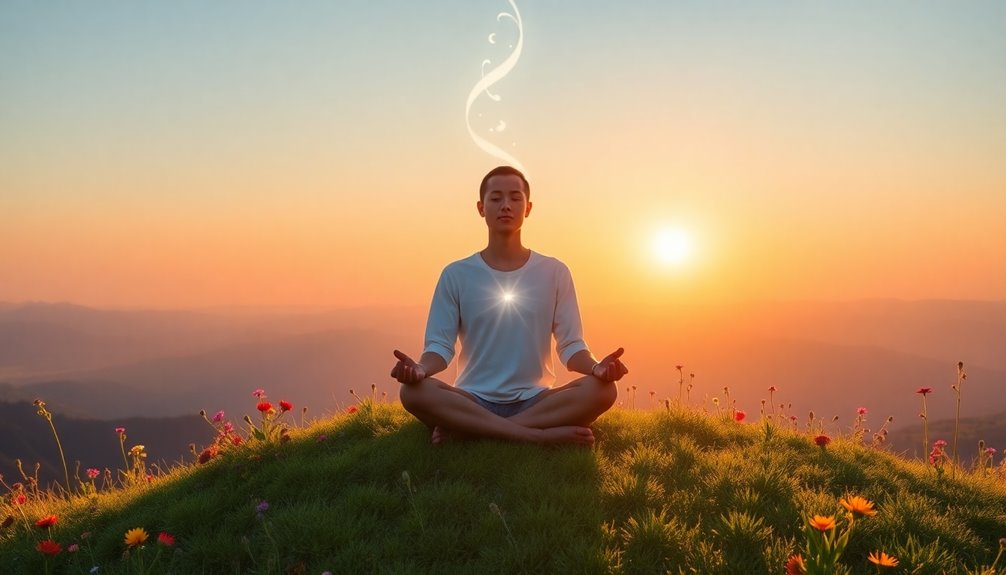Meditation is the powerful technique that many gurus overlook when it comes to manifestation. It helps you align your thoughts and emotions with your intentions, making your desires feel achievable. By focusing on positive emotions, you resonate with abundance, clear unconscious beliefs, and shift your mindset from mere desire to powerful intentions. Timing also plays a role, as meditation during peak energetic phases can amplify your efforts. This straightforward approach is often simpler yet more effective than the flashy methods promoted by others. Discover how to truly enhance your manifestation journey and access your potential.
Key Takeaways
- Focus on aligning your emotions with your intentions during meditation to amplify your manifestation efforts and attract abundance naturally.
- Use visualization techniques that depict your goals as already achieved, reinforcing belief and energetic alignment with your desires.
- Start with smaller intentions in meditation to build confidence and gradually work towards larger goals without creating feelings of lack.
- Practice mindfulness meditation to enhance focus, reduce stress, and connect deeply with your true intentions, supporting emotional resilience.
- Embrace simplicity in your meditation techniques; consistent, straightforward practices yield more significant results than complex, overwhelming methods.
The Power of Visualization

Often, people underestimate the power of visualization in the manifestation process. When you create a vivid mental image of your desired outcome, you activate your brain's neural pathways, effectively programming it to work towards that goal. This technique isn't just a fanciful notion; it's backed by neuroscience, showing that visualization can enhance both performance and motivation.
Just think about athletes who use mental imagery to hone their skills and reach peak performance levels.
Regularly engaging in visualization shifts your mindset from scarcity to abundance, allowing you to truly believe in the possibility of achieving your desires. To amplify its effectiveness, combine visualization with emotional engagement. Feel the joy and excitement of already having what you want; this emotional connection makes the process even more powerful.
However, visualization alone won't bring your dreams to life. You need to take aligned actions that complement your mental imagery. While visualization sets your intentions, physical steps are essential for effective manifestation.
Emotional Resonance in Manifestation

Emotional resonance is the heartbeat of manifestation, as aligning your feelings with your desired outcomes greatly enhances your ability to attract what you want. When you cultivate positive emotions, like gratitude and joy, you create a vibrational match that pulls abundance into your life.
Meditation serves as a powerful tool to help you access and amplify these emotions. By visualizing your desired outcomes while feeling the associated positive emotions, you establish a potent energetic alignment that accelerates the manifestation process. This practice not only strengthens your focus but also heightens your emotional resonance, making it easier to draw in what you seek.
Awareness of your emotional state is essential. When you consciously shift towards uplifting feelings, you considerably improve the effectiveness of your manifestation efforts. Each time you meditate, take a moment to check in with your emotions and adjust them to foster a mindset of abundance.
This alignment allows you to resonate with the frequency of your desires, ultimately making it easier to attract abundance into your life. Embrace the power of emotional resonance, and watch how it transforms your manifestation journey.
Common Myths About Manifestation

Manifestation is surrounded by numerous myths that can cloud your understanding and hinder your progress. One common myth is that constantly focusing on a desire will help you manifest it. In reality, this can create feelings of lack, which actually blocks the manifestation process.
Another misconception is that simply amplifying your desire will speed up results. However, viewing desire as a future-oriented concept can limit your effectiveness in manifesting.
Many people believe that visualization alone is enough for manifestation. While it's a powerful tool, aligned actions and active engagement are equally necessary to turn your desires into reality.
Some think that intentions should be replaced by desires for better outcomes. In truth, intentions foster alignment with your desired experiences, making manifestation more effective.
Lastly, a prevalent myth is that anyone can manifest anything without considering personal alignment with their true purpose. This can lead to unfulfilled desires, distracting you from genuine growth.
Shifting From Desire to Intention

Shifting your focus from desire to intention can greatly enhance your manifestation journey. When you move away from simply wanting something and start believing you already possess it, you align your mindset with abundance rather than lack. This change transforms your desires into clear intentions, fostering a sense of certainty and direction.
To effectively make this alteration, practicing meditation is key. It allows you to assess and adjust your unconscious beliefs, helping you cultivate an abundance mindset. During meditation, visualize your goals as if you've already achieved them. This reinforces the belief that you're in possession of what you desire, making your intentions more powerful.
Start with smaller intentions; this can build your confidence and ease the shift to larger goals. By doing so, you'll find the manifestation process more manageable and effective.
The Role of Timing in Manifestation

Timing is essential when it comes to effectively bringing your desires to life. The role of timing in manifestation can't be overstated. When you align your actions with the natural flow of energy, you enhance the effectiveness of your manifestation process.
Embracing the concept of divine timing means recognizing that your desires will manifest when you're energetically ready to receive them, teaching you patience and trust.
Certain lunar phases, like the new moon, are particularly favorable for setting intentions. These phases symbolize new beginnings and opportunities, making them ideal for your manifestation efforts.
Additionally, engaging in meditation during peak energetic times, such as solstices or equinoxes, can amplify your manifestation process. These periods are infused with heightened spiritual energy that you can harness.
It's also vital to recognize your personal cycles. Assess your emotional and mental readiness before taking action; acting prematurely can hinder your progress and lead to frustration.
Transforming Unconscious Associations

Your beliefs play a significant role in shaping your manifestation journey, often operating beneath the surface of your conscious mind. Transforming unconscious associations is essential for overcoming negative beliefs that block your desired outcomes. By becoming aware of these hidden beliefs, you can shift your mindset and enhance your manifestation process.
Here's a simple table to help you identify and transform your unconscious associations:
| Negative Belief | Positive Reframe | Technique Used |
|---|---|---|
| I never get what I want | I attract abundance | Affirmations |
| I'm not deserving | I am worthy of success | Meditation |
| Failure is inevitable | Every setback is a lesson | Journaling |
| Money is hard to come by | Wealth flows easily to me | Visualizations |
| Love is unattainable | Love is all around me | Gratitude practice |
Regularly evaluating and adjusting these beliefs leads to improved manifestation results. Embrace patience and trust in the process, as this cultivates alignment with your intentions. Acknowledging past disappointments can also deepen your understanding of your true purpose in manifestation, paving the way for personal growth.
Why Gurus Overlook This Technique

Many self-help gurus tend to overlook the powerful technique of silent observation in meditation, favoring more elaborate methods that promise quick results. This technique emphasizes simply observing your thoughts without attachment, allowing you to cultivate awareness and clarity.
Gurus often focus on complex rituals and visualization methods, which can create a sense of exclusivity and attract attention. However, silent observation challenges this reliance on intricate practices, as it highlights the importance of understanding your unconscious beliefs.
The democratic nature of silent observation makes it accessible to anyone, eliminating the need for costly courses or specialized guidance. This can threaten the guru's narrative that you need their expertise for manifestation.
By promoting personal agency, silent observation empowers you to take control of your own transformation, which may undermine the perceived value of a guru's guidance.
Moreover, silent observation aligns seamlessly with manifestation principles, fostering a natural shift in energy. This straightforward approach mightn't generate the sensationalism that many gurus thrive on, but it's ultimately more effective for those willing to embrace it. Additionally, incorporating practices like mindfulness meditation can further enhance your ability to focus and connect with your true intentions.
Frequently Asked Questions
Why Does Manifestation Never Work for Me?
If manifestation never works for you, it might be due to unconscious beliefs that clash with your desires.
You might also be stuck in a scarcity mindset, feeling unworthy of what you want.
Instead of comparing your journey to others, focus on your unique path.
Remember, visualization's not enough; you need to take aligned actions and truly believe you already possess your desires.
Finally, view challenges as growth opportunities to enhance your manifestation efforts.
Who Is the Father of Manifestation?
Picture yourself standing at the edge of a tranquil lake, reflecting on your dreams.
When you ask, "Who's the father of manifestation?" you'll find yourself led to Wayne Dyer. His teachings emphasize the power of your mindset and belief in attracting abundance.
Dyer overcame his challenges, inspiring you to realize your true purpose and embrace the abundance that life offers.
Can You Create the Life You Want Through Manifestation Meditation?
Yes, you can create the life you want through manifestation meditation. By aligning your thoughts and emotions with your desires, you'll shift your energy and attract what you truly seek.
Incorporating visualization and affirmations into your practice helps cultivate an abundance mindset. Regular meditation rewires your beliefs, reduces negativity, and fosters patience.
As you deepen your practice, you'll gain clarity on your true desires, ensuring your manifestations align with your genuine purpose.
Does Manifestation Technique Work?
Can you really create your dream life just by wishing for it? Manifestation techniques can indeed work, but they rely on more than mere desire.
You need to align your beliefs and take action towards your goals. By embracing an abundance mindset and engaging in practices like gratitude, you elevate your emotional energy, making it easier to attract what you want.
Conclusion
In the grand tapestry of manifestation, this overlooked technique is the thread that weaves your desires into reality. By harnessing the power of visualization and emotional resonance, you can ignite a spark that transforms dreams into tangible outcomes. Forget the myths and shift your focus from mere desire to intentional living. As you align your timing and transform your subconscious, watch as the universe opens its doors, ready to deliver the life you've always envisioned.











